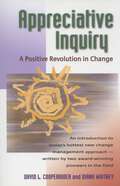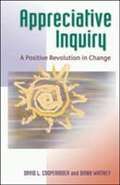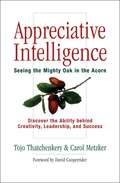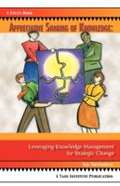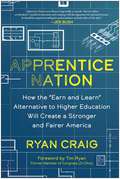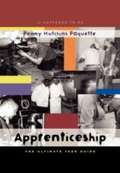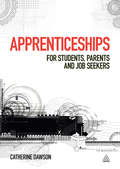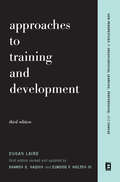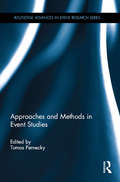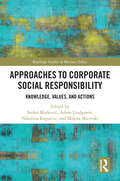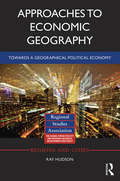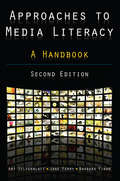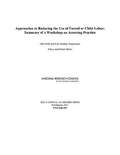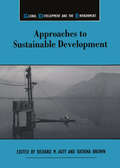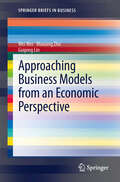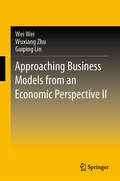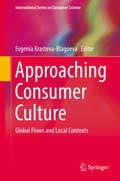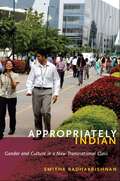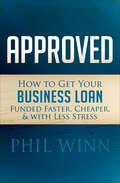- Table View
- List View
Appreciative Inquiry: A Positive Revolution in Change
by Diana D. Whitney David CooperriderWritten by the two most recognized Appreciative Inquiry thought leaders A quick, accessible introduction to one of the most popular change methods today--proven effective in organizations ranging from Roadway Express and British Airways to the United Nations and the United States Navy Appreciative Inquiry (AI) is a model of change management uniquely suited to the values, beliefs, and challenges of organizations today. AI is a process that emphasizes identifying and building on strengths, rather than focusing exclusively on fixing weaknesses as most other change processes do. As the stories in this book illustrate, it results in dramatic improvements in the triple bottom line: people, profits, and planet. AI has been used to significantly enhance customer satisfaction, cost competitiveness, revenues, profits, and employee engagement, retention, and morale, as well as organizations' abilities to meet the needs of society. This book is a concise introduction to Appreciative Inquiry. It provides a basic overview of the process and principles of AI along with exciting stories illustrating how organizations have applied AI and the benefits they have gained as a result. It has been specifically designed to be accessible to a wide audience so that it can be handed out in organizations where AI is either being contemplated or being implemented. Written by two of the key figures in the development of Appreciative Inquiry, this is the most authoritative guide available to a change method that systematically taps the potential of human beings to make themselves, their organizations, and their communities more adaptive and more effective.
Appreciative Inquiry: A Positive Revolution in Change
by Diana Whitney David L. CooperriderThis short, practical guide offers an approach to organizational change based on the possibility of a more desirable future, experience with the whole system, and activities that signal "something different is happening this time."
Appreciative Intelligence: Seeing the Mighty Oak in the Acorn
by Tojo Thatchenkery Carol MetzkerAppreciative Intelligence provides a new answer to what enables successful people to dream up their extraordinary and innovative ideas; why employees, partners, colleagues, investors, and other stakeholders join them on the path to their goals, and how they achieve these goals despite obstacles and challenges. It is not simple optimism. People with appreciative intelligence are realistic and action oriented--they have the ability not just to identify positive potential, but to devise a course of action to take advantage of it. Drawing on their own original research and recent discoveries in psychology and cognitive neuroscience, Thatchenkery and Metzker outline the evidence for appreciative intelligence, detail its specific characteristics, and show how you can develop this skill and use it in your own life and work. They show how the most successful leaders are able to spread appreciative intelligence throughout an organization, and they offer tools and exercises you can use to increase your own level of appreciative intelligence and so become more creative, resilient, successful, and personally fulfilled.
Appreciative Sharing of Knowledge: Leveraging Knowledge Management for Strategic Change
by Tojo ThatchenkeryThis book is dedicated to the development of social constructionist theory and practices for purposes of world benefit. Constructionist theory and practice locate the source of meaning, value and action in communicative relations among people. Chief importance is placed on relational process and its outcomes for the welfare of all. These books are designed for scholars, practitioners, students and the openly curious.
Apprentice Nation: How the "Earn and Learn" Alternative to Higher Education Will Create a Stronger and Fairer America
by Ryan CraigCollege isn&’t for everyone. It&’s time to challenge the status quo and embrace the potential of apprenticeships in tech, healthcare, finance, and more—which can provide a sustainable pathway to economic opportunity. For decades, college has been the only respectable way to access the world of work, despite paralyzing tuition and a dire lack of practical skills that has left 40 percent of college graduates underemployed, unfulfilled, and struggling to repay student loan debt. Education and workforce expert Ryan Craig explores how a modern apprenticeship system will allow students and job seekers to jump-start their careers by learning while they earn—ultimately leading to greater workforce diversity and geographic mobility. With a deep dive into the history behind America&’s outdated college system, Craig reveals: The origins of the student debt crises and admissions scandals Why apprenticeships are an effective pathway to career opportunity What America can do to catch up with other nations making apprenticeship opportunities broadly available Where students and job seekers can go to land an apprenticeship Featuring a directory of US apprenticeship programs by industry and location, Apprentice Nation is an accessible blueprint for a country where young Americans of all backgrounds can launch careers in a variety of in-demand fields. With just a few common sense changes to education and workforce development, anapprentice nation will put the American Dream within reach—for everyone.
Apprenticeship in Early Modern Europe
by Maarten Prak Patrick WallisThis is the first comparative and comprehensive account of occupational training before the Industrial Revolution. Apprenticeship was a critical part of human capital formation, and, because of this, it has a central role to play in understanding economic growth in the past. At the same time, it was a key stage in the lives of many people, whose access to skills and experience of learning were shaped by the guilds that trained them. The local and national studies contained in this volume bring together the latest research into how skills training worked across Europe in an era before the emergence of national school systems. These essays, written to a common agenda and drawing on major new datasets, systematically outline the features of what amounted to a European-wide system of skills education, and provide essential insights into a key institution of economic and social history.
Apprenticeship: The Ultimate Teen Guide
by Penny Hutchins PaquetteIntended for high school students, this vocational reference describes 100 plus apprentice-able jobs in the construction, entertainment, health care, maintenance, personal care, production, and protective services industries, social services, and military. Each entry overviews the work performed, the job outlook and wages in the field, apprenticeship programs, and related skills. Annotation ©2005 Book News, Inc., Portland, OR (booknews.com)
Apprenticeships
by Catherine DawsonAs unemployment becomes an issue on every graduate's and career changer's mind, apprenticeships are becoming the most legitimate and popular routes into work. But how do you choose the apprenticeship that's right for you? And for parents, how do you support and guide your child into the best possible career path? Apprenticeships uses friendly and jargon-free language to answer all of those questions and more. Based on real life experiences and insider knowledge it dispels common misconceptions, helps you assess all the alternatives, provides self assessment questionnaires and practical guidance on the application process. For both school leavers and adult learners, this is the only resource you'll need to make an informed decision. With information on funding, your rights, developing skills as well as information on key national and regional learning providers, Apprenticeships will give you the confidence and knowledge to pursue your chosen career and compete with other candidates.
ApproTEC Kenya: Technologies to Fight Poverty and Create Wealth
by V. Kasturi RanganApproTEC markets a range of technologies to improve the income of subsistence farmers and other small-scale entrepreneurs in East Africa. Having achieved considerable success in its first eight years, the two founders/entrepreneurs are seeking ways to scale the impact of its operations across Eastern and Southern Africa. The question is, what should they do to accomplish this? Includes color exhibits.
Approaches To Training And Development: Third Edition Revised And Updated (New Perspectives In Organizational Learning, Performance, And Change Ser.)
by Dugan Laird Elwood F. Holton Sharon NaquinApproaches to Training and Development provides a comprehensive and practical introduction to the field of organizational training and human-resource development. It surveys the methods, functions, and goals of training--from needs assessment to implementation--illustrating each step of an effective training program. This new edition includes updates throughout, with fresh examples and current references, with an emphasis on evaluating and explaining new training. Comprehensive, authoritative, and accessible, this new edition will prove an essential resource to a new generation of trainers, HRD professionals, educators, and managers.
Approaches and Methods in Event Studies (Routledge Advances in Event Research Series)
by Tomas PerneckyThe recent proliferation of events as a subject of study in its own right has signalled the emergence of a new field – event studies. However, whilst the management-inspired notion of planned events, which strives for conceptual slenderness, may indeed be useful for event managers, the moment we attempt to advance knowledge about events as social, cultural and political phenomena, we realise the extent to which the field is theoretically impoverished. Event studies, it is argued, must transcend overt business-like perspectives in order to grasp events in their complexities. This book challenges the reader to reach beyond the established modes of thinking about events by placing them against a backdrop of much wider, critical discourse. Approaches and Methods in Event Studies emerges as a conceptual and methodological tour de force—comprising the works of scholars of diverse backgrounds coming together to address a range of philosophical, theoretical, and methods-related problems. The areas covered include the concepts of eventification and eventual approaches to events, a mobilities paradigm, rhizomatic events, critical discourse analysis, visual methods, reflexive and ethnographic research into events, and indigenous acumen. Researchers and students engaged in the study of events will draw much inspiration from the contributions and from the volume as a whole.
Approaches for Ecosystem Services Valuation for the Gulf of Mexico After the Deepwater Horizon Oil Spill
by Committee on the Effects of the Deepwater Horizon Mississippi Canyon-252 Oil Spill on Ecosystem Services in the Gulf of MexicoOn April 20, 2010, the Deepwater Horizon platform drilling the Macondo well in Mississippi Canyon Block 252 (DWH) exploded, killing 11 workers and injuring another 17. The DWH oil spill resulted in nearly 5 million barrels (approximately 200 million gallons) of crude oil spilling into the Gulf of Mexico (GoM). The full impacts of the spill on the GoM and the people who live and work there are unknown but expected to be considerable, and will be expressed over years to decades. In the short term, up to 80,000 square miles of the U. S. Exclusive Economic Zone (EEZ) were closed to fishing, resulting in loss of food, jobs and recreation. The DWH oil spill immediately triggered a process under the U. S. Oil Pollution Act of 1990 (OPA) to determine the extent and severity of the "injury" (defined as an observable or measurable adverse change in a natural resource or impairment of a natural resource service) to the public trust, known as the Natural Resources Damage Assessment (NRDA). The assessment, undertaken by the trustees (designated technical experts who act on behalf of the public and who are tasked with assessing the nature and extent of site-related contamination and impacts), requires: (1) quantifying the extent of damage; (2) developing, implementing, and monitoring restoration plans; and (3) seeking compensation for the costs of assessment and restoration from those deemed responsible for the injury. This interim report provides options for expanding the current effort to include the analysis of ecosystem services to help address the unprecedented scale of this spill in U. S. waters and the challenges it presents to those charged with undertaking the damage assessment.
Approaches to Corporate Social Responsibility: Knowledge, Values, and Actions (Routledge Studies in Business Ethics)
by Adam Lindgreen Nikolina Koporcic Stefan Markovic Milena MicevskiFollowing recent growth of ethical consumerism, customers and other stakeholders increasingly pressure organizations to be socially responsible and minimize their negative impact on the environment. Accordingly, a plethora of firms have integrated corporate social responsibility (CSR) at the center of their business strategies and actions. Whilst this has resulted in many firms meeting their broader responsibilities toward society and the environment, some firms have used CSR in a manipulative and insincere way. As stakeholders become aware of such misuse of CSR, largely thanks to the rapid evolution of information technologies, they start to penalize firms by spreading negative word of mouth about them, and specifically about their CSR knowledge, values, and actions. Now, more than ever before, stakeholders are increasingly critical and cautious in their assessments of firms’ CSR knowledge, values, and actions. On this background, this edited volume sheds light on different internal and external perspectives spanning CSR knowledge, values, and actions. It shares theoretical, practical, and case-based insights on the broader topic and can be of interest to researchers, academics, practitioners, and advanced students in the fields of CSR and business ethics, knowledge management, strategy, and marketing.
Approaches to Economic Geography: Towards a geographical political economy (Regions and Cities)
by Ray HudsonThe last four decades have seen major changes in the global economy, with the collapse of communism and the spread of capitalism into parts of the world from which it had previously been excluded. Beginning with a grounding in Marxian political economy, this book explores a range of new ideas as to what economic geography can offer as it intersects with public policy and planning in the new globalised economy. Approaches to Economic Geography draws together the formidable work of Ray Hudson into an authoritative collection, offering a unique approach to the understanding of the changing geographies of the global economy. With chapters covering subjects ranging from uneven development to social economy, this volume explores how a range of perspectives, including evolutionary and institutional approaches, can further elucidate how such economies and their geographies are reproduced. Subsequent chapters argue that greater attention must be given to the relationships between the economy and nature, and that more consideration needs to be given to the growing significance of illegal activities in the economy. The book will be of interest to students studying economic geography as well as researchers and policy makers that recognise the importance of the relationships between economy and geography as we move towards a sustainable future economy and society.
Approaches to Media Literacy: A Handbook
by Art Silverblatt Jane Ferry Barbara FinanCompletely updated, with current examples and new coverage of digital media, this popular handbook provides a range of qualitative approaches that enable students to effectively decipher information conveyed through the channels of mass communication - photography, film, radio, television, and interactive media. It aim is to help students develop critical thinking skills and strategies with regard to what media to use and how to interpret the information that they receive. The techniques include ideological, autobiographical, nonverbal, and mythic approaches. An Instructor's Manual is available to professors who adopt this new edition.
Approaches to Reducing the Use of Forced or Child Labor: Summary of a Workshop on Assessing Practice
by National Research Council of the National AcademiesGlobally, child labor and forced labor are widespread and complex problems. They are conceptually different phenomena, requiring different policy responses, though they may also overlap in practice. The Trafficking Victims Protection Act of 2000 (TVPA) was designed to reduce the use of child and forced labor in the production of goods consumed in the United States. The Act was reauthorized in 2003, 2005, and 2008. In response to provisions of TVPA, the the Bureau of International Labor Affairs requested that the National Research Council organize a two-day workshop. The workshop, summarized in this volume, discusses methods for identifying and organizing a standard set of practices that will reduce the likelihood that persons will use forced labor or child labor to produce goods, with a focus on business and governmental practices.
Approaches to Sustainable Development
by Katrina Brown Richard M. AutyA definition of sustainable development is that of the Brundtland Commission - "...development which meets the needs of the current generation without jeopardizing the needs of future generations". This volume seeks to analyze the economic basis for this definition, and to look at the critiques of the economic approach - which have their basis in growing disquiet over the role of the productive normative science driving technological change and economic transformation. The discussion is followed by studies of the application of the criteria of sustainability to rural problems in South Asia, Kenya, Nepal, and Latin America and to urban/industrial problems in Jamaica, Chile and Vietnam.
Approaching Architecture: Three Fields, One Discipline
by Miguel GuitartThe study of the architectural discipline suffers from an increasing disconnect between its teaching and its professional practice. In this edited collection, 18 architectural voices address this disconnect by reflecting on the ways in which they exercise the architectural discipline in three ways: research, teaching, and practice. This book argues that the totality of activities encompassed by the architectural profession can be best fulfilled when reconsidering the critical interactions between these three fields in the everyday exercise of the profession. Split into three parts, "Architecture as Research," Architecture as Pedagogy," and "Architecture as Practice," each section focuses on one of these three dimensions while establishing continuity with the other two. In doing so, the book not only favors a more fulfilling interaction between academia and the profession but also reinforces the implementation of design theory and research in everyday teaching and practice. The contributions come from 18 teams of architects operating from geographically diverse locations, including Pezo von Ellrichshausen in Chile, Kengo Kuma & Associates in Japan, Barclay & Crousse in Peru, Shift in Iran, Heinrich Wolff in South Africa, and People’s Architecture Office in China, opening the design conversation to larger contexts and framing continuity and inclusion in time. Written for students, instructors, and practitioners alike, the inspiring reflections in this volume encourage readers to grow as architects and play an instrumental role in transforming the built environment.
Approaching Architecture: Three Fields, One Discipline
by Miguel GuitartThe study of the architectural discipline suffers from an increasing disconnect between its teaching and its professional practice. In this edited collection, 18 architectural voices address this disconnect by reflecting on the ways in which they exercise the architectural discipline in three ways: research, teaching, and practice. This book argues that the totality of activities encompassed by the architectural profession can be best fulfilled when reconsidering the critical interactions between these three fields in the everyday exercise of the profession. Split into three parts, "Architecture as Research," Architecture as Pedagogy," and "Architecture as Practice," each section focuses on one of these three dimensions while establishing continuity with the other two. In doing so, the book not only favors a more fulfilling interaction between academia and the profession but also reinforces the implementation of design theory and research in everyday teaching and practice. The contributions come from 18 teams of architects operating from geographically diverse locations, including Pezo von Ellrichshausen in Chile, Kengo Kuma & Associates in Japan, Barclay & Crousse in Peru, Shift in Iran, Heinrich Wolff in South Africa, and People’s Architecture Office in China, opening the design conversation to larger contexts and framing continuity and inclusion in time. Written for students, instructors, and practitioners alike, the inspiring reflections in this volume encourage readers to grow as architects and play an instrumental role in transforming the built environment.
Approaching Business Models from an Economic Perspective (SpringerBriefs in Business)
by Wuxiang Zhu Wei Wei Guiping LinApproaching Business Models from an Economic Perspective examines business model logic and explores the model from different aspects including definition, design, functionality, elements, and self-sustaining logic. It explains the essence and core elements of a business model and unlocks its mysteries, helping transform business model practices into an expedient set of theories that in turn facilitate application in real scenarios. The book explores the logic behind the six major elements and enables entrepreneurs to study and implement business model theory and make decisions confidently based on a compelling logic. Moreover, it demonstrates through an array of convincing examples that a transaction structure and its six elements follow the principles of increasing transaction value, reducing transaction costs, and mitigating transaction risks.
Approaching Business Models from an Economic Perspective II
by Wuxiang Zhu Wei Wei Guiping LinThis book breaks the boundaries of the single enterprise, proposing the symbiotic business model, and discussing business model design engineering as well as other new concepts, methods and ideas. Business models are not only dependent on business intuition, but also on systematic design and continuous upgrade. This book presents qualitative methods, such as the theory and principles of business model design; quantitative methods, for example the business-model based "Accounting Method"; and the "Financial Analysis Method," based on the business ecosystem. These methods help entrepreneurs and managers design better business models to further develop enterprises and make them more successful.
Approaching China's Pharmaceutical Market: A Fundamental Guide to Clinical Drug Development
by Ming Q. LuThis authoritative volume examines the major laws, regulations and guidelines related to pharmaceutical product development in China. With a focus on patent, clinical and registration strategies, the book helps Western companies introduce their clinical drugs to the Chinese market, determine a strategic path and bridge the gap for regulatory and legal differences between China and the Western world. For a better understanding of the drug registration process, it explores the differences between the China Food and Drug Administration (CFDA)--including its regulations and registration procedures--and those of the Western world. The volume discusses disparities between China's application requirements compared to Western standards to make it easier for companies to prepare their application packages. It also provides detailed commentary on CFDA guidelines in reference to clinical trial (IND) and market application (NDA) requirements. Overall, this book offers guidance for Western companies aspiring to expand into China's pharmaceutical market in hopes that they may gain a fundamental understanding of its rules and complexities in order to ensure a smooth transition and prevent future issues.
Approaching Consumer Culture
by Evgenia Krasteva-BlagoevaThis fascinating collection analyzes the impact of Western consumer culture on local cultures and consumption in Southeast Europe and East Asia. Cultural, historical, economic and sociopolitical contexts are examined regarding buying behaviors, usage and customization practices and consumer activism, specifically in Bulgaria, Serbia, and Romania as cultures continue to evolve in the post-socialist era, and in China and Japan as a continuation of movements toward modernity and progress. Surprising and thought-provoking contrasts stand out as consumers balance the global with the local in terms of clothing, technology, luxury items, and food. All chapters feature a wealth of empirical and cross-cultural data, and the presentation is framed by Professor Mike Featherstone’s theoretical essay on the origins of consumer culture and the consequences of two hundred years of increasing consumption for the human condition and the future of the planet.Included in the coverage:“You are a socialist child like me”: Goods and Identity in BulgariaConsumer Culture from Socialist Yugoslavia to Post-Socialist Serbia: Movements and MomentsPreserves Exiting Socialism: Authenticity, Anti-Standardization, and Middle-Class Consumption in Post-Socialist RomaniaModernization and the Department Store in Early 20th-Century Japan: Modern Girl and New Consumer Culture LifestylesA Cultural Reading of Conspicuous Consumption in ChinaApproaching Consumer Culture broadens the cultural anthropology literature and will be welcomed by Western and Eastern scholars and researchers alike. Its depth and accessibility make it useful to university courses in cultural anthropology, cultural studies, and sociology.
Appropriately Indian: Gender and Culture in a New Transnational Class
by Smitha RadhakrishnanAppropriately Indian is an ethnographic analysis of the class of information technology professionals at the symbolic helm of globalizing India. Comprising a small but prestigious segment of India's labor force, these transnational knowledge workers dominate the country's economic and cultural scene, as do their notions of what it means to be Indian. Drawing on the stories of Indian professionals in Mumbai, Bangalore, Silicon Valley, and South Africa, Smitha Radhakrishnan explains how these high-tech workers create a "global Indianness" by transforming the diversity of Indian cultural practices into a generic, mobile set of "Indian" norms. Female information technology professionals are particularly influential. By reconfiguring notions of respectable femininity and the "good" Indian family, they are reshaping ideas about what it means to be Indian. Radhakrishnan explains how this transnational class creates an Indian culture that is self-consciously distinct from Western culture, yet compatible with Western cosmopolitan lifestyles. She describes the material and symbolic privileges that accrue to India's high-tech workers, who often claim ordinary middle-class backgrounds, but are overwhelmingly urban and upper caste. They are also distinctly apolitical and individualistic. Members of this elite class practice a decontextualized version of Hinduism, and they absorb the ideas and values that circulate through both Indian and non-Indian multinational corporations. Ultimately, though, global Indianness is rooted and configured in the gendered sphere of home and family.
Approved: How to Get Your Business Loan Funded Faster, Cheaper, & with Less Stress
by Phil WinnThis straightforward road map guides you through the SBA loan approval process—from business plan preparation to submitting a foolproof application. Few entrepreneurs are aware of the benefits and opportunities available through the Small Business Administration (SBA), mainly because there are few resources available to guide them through the process. Approved was written to fill that gap by providing a step-by-step guide to SBA loan approval—bypassing the difficulties, delays, and expenses that can complicate the procedure. After finishing Approved, you will be able to highlight strengths (and mitigate weaknesses) from a lender&’s perspective, provide a simple business plan identifying how the business will be profitable for the long term, and accurately prepare a business loan application that can be immediately submitted through underwriting—unlike most business applications.
